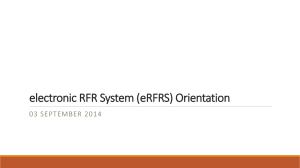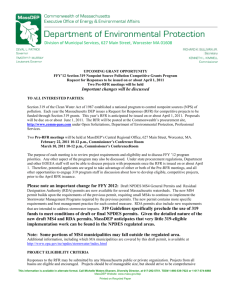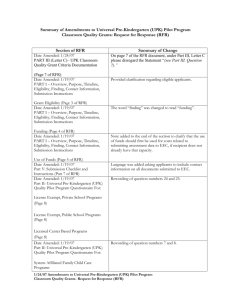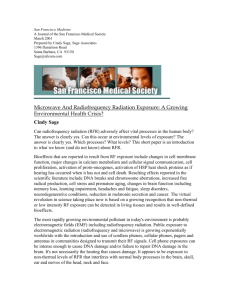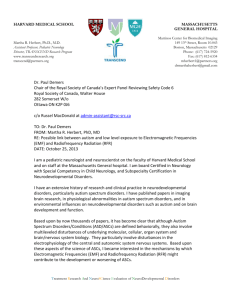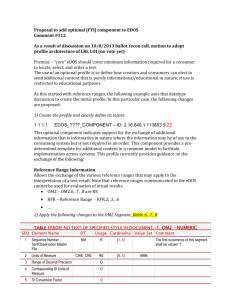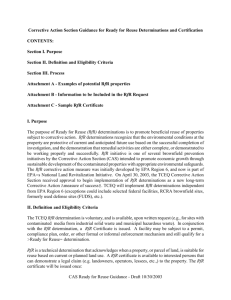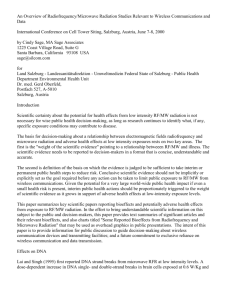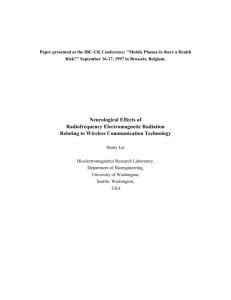EMFcall10-18-12Laipa.. - Collaborative on Health and the
advertisement
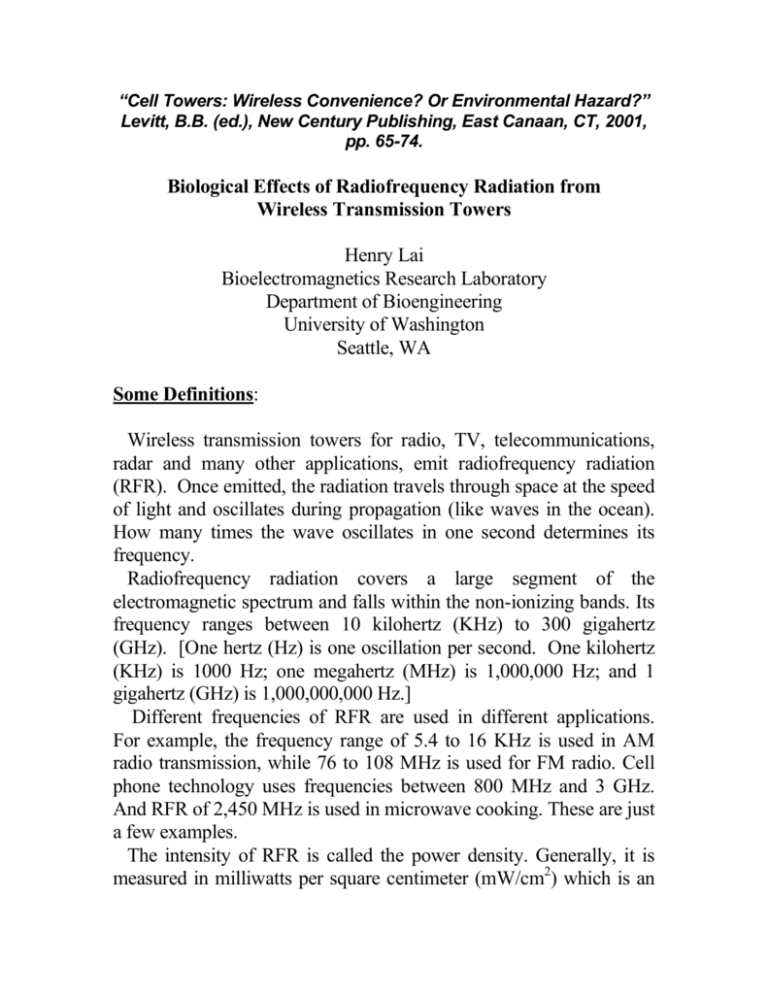
“Cell Towers: Wireless Convenience? Or Environmental Hazard?” Levitt, B.B. (ed.), New Century Publishing, East Canaan, CT, 2001, pp. 65-74. Biological Effects of Radiofrequency Radiation from Wireless Transmission Towers Henry Lai Bioelectromagnetics Research Laboratory Department of Bioengineering University of Washington Seattle, WA Some Definitions: Wireless transmission towers for radio, TV, telecommunications, radar and many other applications, emit radiofrequency radiation (RFR). Once emitted, the radiation travels through space at the speed of light and oscillates during propagation (like waves in the ocean). How many times the wave oscillates in one second determines its frequency. Radiofrequency radiation covers a large segment of the electromagnetic spectrum and falls within the non-ionizing bands. Its frequency ranges between 10 kilohertz (KHz) to 300 gigahertz (GHz). [One hertz (Hz) is one oscillation per second. One kilohertz (KHz) is 1000 Hz; one megahertz (MHz) is 1,000,000 Hz; and 1 gigahertz (GHz) is 1,000,000,000 Hz.] Different frequencies of RFR are used in different applications. For example, the frequency range of 5.4 to 16 KHz is used in AM radio transmission, while 76 to 108 MHz is used for FM radio. Cell phone technology uses frequencies between 800 MHz and 3 GHz. And RFR of 2,450 MHz is used in microwave cooking. These are just a few examples. The intensity of RFR is called the power density. Generally, it is measured in milliwatts per square centimeter (mW/cm2) which is an energy relationship that exists in space. However, biological effects depend on how much of the energy is absorbed in the body of a living organism, not just what exists in space. Absorption of RFR depends on many factors including the transmission frequency and the intensity, the duration of exposure, and one’s distance from the source. Other factors include an organism’s size, shape, water content, and orientation toward the radiating source. Children, for instance, absorb energy differently than adults. The term used to describe the absorption of radiofrequency radiation is “specific absorption rate” or SAR, which is the rate of energy that is actually absorbed. Specific absorption rates are measured in watts per kilogram (W/kg) of tissue. Specific absorption rates are a more reliable determinant and index of RFR biological effects than are power densities because SARs reflect what is actually being absorbed rather than an energy quotient in space. In addition to SARs, there are some indications that biological effects may also depend on how energy is deposited in the body. Different propagation characteristics such as ‘modulation,’ or different wave-forms and shapes may have different effects on a living system. For example, the same amount of energy can be delivered to tissue ‘continuously’ or ‘in short pulses’. Different biological effects may result depending on the type, kind, and duration of the exposure. Transmission Facilities: The intensity of RFR decreases with the distance from the generating source, therefore exposure to RFR from transmission towers is usually of low intensity depending on one’s proximity. But intensity is not the only factor. Living near a facility means the exposure will be of a long duration because a person will be exposed to radiation for many hours in the day. Thus, the relevant questions are: (1) Do biological/health effects occur after exposure to lowintensity RFR? (2) Do effects accumulate over time, since the exposure is of a long duration and is usually intermittent? (3) What precisely is low-intensity RFR and what might its biological effects be? (4) What does the science tell us about such exposures? RFR Government Guidelines: How Spatial Energy Translates to the Body’s Absorption: The U.S. Federal Communications Commission has issued guidelines for both power density and specific absorption rates. For power density, the U.S. guidelines are between 0.2 - 1 mW/cm2. At 100-200 ft from a cell phone base station, a person can be exposed to a power density of 0.001 mW/cm2 (i.e. 1 microwatt/cm2). The Specific Absorption Rate (SAR) at such a distance can be 0.001 W/kg (i.e., 1 milliwatt/kg). The U.S. guidelines for SARs are between 0.08 - 0.4 W/kg. Thus, lets define low-intensity exposure to RFR of power density of 0.001 mW/cm2, or a SAR of 0.001 W/kg. Biological Effects at Low Intensities: Do biological effects occur at such low intensities? Many have been documented. Here are some examples of biological effects that occurred in studies of cell cultures and animals after exposures to low-intensity RFR: (1) De Pomerai et al. [2000] reported an increase in a molecular stress response in cells after exposure to a RFR at a SAR of 0.001 W/kg. This stress response is a basic biological process that is present in almost all animals -- including humans. (2) Dutta et al. [1989] reported an increase in calcium efflux in cells after exposure to RFR at 0.005 W/kg. Calcium is an important component of normal cellular functions. (3) Fesenko et al. [1999] reported a change in immunological functions in mice after exposure to RFR at a power density of 0.001 mW/cm2. (4) Magras and Xenos [1999] reported a decrease in reproductive function in mice exposed to RFR at power densities of 0.000168 0.001053 mW/cm2. (5) Persson et al. [1997] reported an increase in the permeability of the blood-brain barrier in mice exposed to RFR at 0.0004 -0.008 W/kg. The blood-brain barrier envelops the brain and protects it from toxic substances. (6) Phillips et al. [1998] reported DNA damage in cells exposed to RFR at SAR of 0.0024 - 0.024 W/kg. (7) Velizarov et al. [1999] showed a decrease in cell proliferation (division) after exposure to RFR of 0.000021-0.0021 W/kg. These are important findings at such low-intensity exposures. There are many other reports in the recent research literature showing biological effects in cell cultures and animals after exposure to lowintensity RFR. But we don’t know if these effects occur in humans exposed to low-intensity RFR, or whether the reported effects are health hazards. Biological effects do not automatically mean adverse health effects. Many biological effects are reversible. However, it is very clear that low-intensity RFR is not biologically inert. Much more needs to be learned, however, before a presumption of safety can be made. Long-Term Exposures and Cumulative Effects: There are flaws and important gaps in the RFR research. The majority of the studies on RFR have been conducted with short-term exposures, i.e. a few minutes to several hours. Little is known about the effects of long-term exposure such as would be experienced by people living near telecommunications installations, especially with exposures spanning months or years. What are the effects of longterm exposure? Does long-term exposure produce different effects from short-term exposure? Do effects accumulate over time? There is some evidence that effects of RFR do accumulate over time. Here are some examples: (1) Phillips et al. [1998] reported DNA damage in cells after 24 hours of exposure to low intensity RFR. DNA damage can lead to gene mutation, which accumulates over time. (2) Magras and Xenos [1999] reported that mice exposed to lowintensity RFR became less reproductive. After five generations of exposure, the mice were not able to produce offspring. This shows that the effect of RFR can pass from one generation to another. (3) Persson et al. [1997] reported an increase in permeability of the blood-brain barrier in mice when the energy deposited in the body exceeded 1.5 J/kg (joule per kilogram) -- a measurement of the total amount of energy deposited. This suggests that a short-term/high intensity exposure can produce the same effect as a long-term/low intensity exposure. This is another indication that RFR effects can accumulate over time. There is some indication that an animal becomes more sensitive to the radiation after long-term exposure. Let us consider two of the critical experiments that contributed to the present U.S. RFRexposure standards -- the ‘Behavior-Disruption Experiments’ carried out in the 1980s: In the first experiment, de Lorge and Ezell [1980] trained rats on an ‘auditory observing-response task’. In the task, an animal was presented with two bars. Pressing the right bar would produce either a low-pitch or a high-pitch tone for half a second. The low-pitch tone signaled an ‘unrewarded’ situation and the animal was expected to do nothing. However, when the high-pitch tone was on, pressing the left bar would produce a food reward. Thus, the task required continuous vigilance in which an animal had to coordinate its motor responses according to the stimulus presented in order to get a reward by choosing between a high pitch or low pitch tone. After learning the task, rats were then irradiated with 1280-MHz or 5620-MHz RFR during performance. Disruption of behavior (i.e., the rats couldn’t perform very well) was observed at a SAR of 3.75 W/kg for 1280MHz and 4.9 W/kg for 5620-MHz. Disruption occurred within 3060 minutes of exposure. In another experiment, de Lorge [1984] trained monkeys on a similar ‘auditory observing-response task’. Monkeys were exposed to RFR of 225, 1300, and 5800 MHz. Disruption of performance was observed at 8.1 mW/cm2 (SAR 3.2 W/kg) for 225-MHz, 57 mW/cm2 (SAR 7.4 W/kg) for 1300 MHz, and 140 mW/cm2 (SAR 4.3 W/kg) for 5800 MHz. The disruption occurred when body temperature was increased by 1oC. The conclusion from these experiments is that ‘disruption of behavior occurred when an animal was exposed at a SAR of approximately 4 W/kg, and disruption occurred after 30-60 minutes of exposure and when body temperature increased by 1oC.’ Thus, the 4 W/kg figure is used in the setting of the present U.S. RFR exposure guidelines for humans with theoretical margins of safety added. With this, the limit for occupational exposure was set at 0.4 W/kg (i.e. 1/10 of the SAR where effects were observed) and for public exposure 0.08 W/kg (i.e. 1/5 of that of occupational exposure). But is this standard adequate? The studies described above are effects of short-term exposure (less than 1 hour). Are they comparable to long-term exposure? The same investigators of the above short-term exposure experiments reported two series of experiments in 1986 on the effects of long-term exposure. Here are the results: D’Andrea et al. [1986a] exposed rats to 2450-MHz RFR for 7 hours a day, 7 days a week for 14 weeks. They reported a disruption of behavior at an SAR of 0.7 W/kg. D’Andrea et al. [1986b] also exposed rats to 2450-MHz RFR for 7 hours a day, 7 days a /week, for 90 days at an SAR of 0.14 W/kg and found a small but significant disruption in behavior. The experimenters concluded, “the threshold for behavioral and physiological effects of chronic (long-term) RFR exposure in the rat occurs between 0.5 mW/cm2 (0.14 W/kg) and 2.5 mW/cm2 (0.7 W/kg).” Thus, RFR can produce an effect at much lower intensities after an animal is chronically exposed. This can have very significant implications for people exposed to RFR from transmission towers. Other Observations: Other biological outcomes also have been reported after long-term exposure to RFR: (1) Effects were observed after prolonged, repeated exposure but not after short-term exposure [e.g., Baranski, 1972; Takashima et al., 1979]. (2) Effects that were observed after short-term exposure, disappeared after prolonged, repeated exposure (habituation) [e.g., Johnson et al., 1983; Lai et al., 1987, 1992]. (3) Different effects were observed after different durations of exposure [e.g., Dumanski and Shandala, 1974; Lai et al., 1989]. The conclusion from this body of work is that effects of long-term exposure can be quite different from those of short-term exposure. Effects Below 4 W/kg: Thermal v. Non-Thermal There are many studies that show biological effects at SARs less than 4 W/kg after short-term exposure to RFR. For example, effects on behavior have been observed at SARs less than 4 W/kg. (D’Andrea et al [1986a,b] 0.14 to 0.7 W/kg; DeWitt et al. [1987] 0.14 W/kg; Gage [1979] 3 W/kg; King et al. [1971] 2.4 W/kg; Lai et al. [1989] 0.6 W/kg; Mitchell et al. [1977] 2.3 W/kg; Navakatikian and Tomashevskaya [1994] 0.027 W/kg; Schrot et al. [1980] 0.7 W/kg; Thomas et al. [1975] 1.5 to 2.7 W/kg; Wang and Lai [2000] 1.2 W/kg). For decades, there have been questions about whether an effect is thermal (i.e., a significant change in temperature) or non-thermal (i.e., no significant change in temperature). The present guidelines, as mentioned before, are based on thermal effects (e.g., a change of body temperature of 1oC). However, this distinction is now obsolete. We actually don’t need to know whether RFR effects are thermal or non-thermal to set exposure guidelines for RFR exposure. Most of the studies on biological effects of RFR carried out since the 1980’s were under ‘non-thermal’ conditions. In studies using isolated cells, the ambient temperature during exposure was generally well controlled. In most animal studies, the RFR intensity used usually did not cause a significant increase in body temperature of the animals exposed. But scientists continue to wonder about non-thermal effects. Most scientists recognize that non-thermal effects are established, even as the implications are not fully understood. There are several arguments for the existence of non-thermal effects: (1) There are reports that RFRs of the same frequency and intensity but with different modulations and waveforms produce different effects [Arber and Lin, 1985; Baranski, 1972; Frey et al., 1975; Oscar and Hawkins, 1977; Sanders et al., 1985]. (2) RFR triggers effects different from an increase in temperature [D'Inzeo et al., 1988; Seaman and Wachtel, 1978; Wachtel et al., 1975]. (3) Effects are observed with RFR of very low intensities, when temperature increase is unlikely [e.g., dePomerai et al., 2000]. Conclusion: (1) Biological effects do occur after a short-term exposure to lowintensity RFR. However, potential hazardous health effects of such exposure to humans are not clear. (2) Not much is known about the biological effects of long-term exposure. The effects of long-term exposure can be quite different from those of short-term exposure. (3) The present U.S. guidelines for RFR exposure are not up-todate. The most recent IEEE Guidelines only included research data up to 1985. In addition, effects of long-term exposure, modulation and other propagation characteristics are not considered. Therefore, the current guidelines are questionable in protecting the public from possible harmful effects of RFR exposure. (4) Exposure of the general population to RFR from wireless communication devices and transmission towers should be kept to a minimum and should follow the ALAR principle – ‘As Low As Reasonably Achievable’. Literature cited: Arber, S.L., and Lin, J.C., 1985, Microwave-induced changes in nerve cells: effects of modulation and temperature, Bioelectromagnetics 6:257-270. Baranski, S., 1972, Histological and histochemical effects of microwave irradiation on the central nervous system of rabbits and guinea pigs, Am J Physiol Med 51:182-190. D'Andrea, J.A., DeWitt, J.R., Emmerson, R.Y., Bailey, C., Stensaas, S., and Gandhi, O. P., 1986a, Intermittent exposure of rat to 2450MHz microwaves at 2.5 mW/cm2: behavioral and physiological effects, Bioelectromagnetics 7:315-328. D'Andrea, J.A., DeWitt, J.R., Gandhi, O. P., Stensaas, S., Lords, J.L., and Nielson, H.C., 1986b, Behavioral and physiological effects of chronic 2450-MHz microwave irradiation of the rat at 0.5 mW/cm2, Bioelectromagnetics 7:45-56. de Lorge, J.O. , 1984, Operant behavior and colonic temperature of Macaca mulatta exposed to radiofrequency fields at and above resonant frequencies. Bioelectromagnetics 5:233-246. de Lorge, J., and Ezell, C.S., 1980, Observing-responses of rats exposed to 1.28- and 5.62-GHz microwaves, Bioelectromagnetics 1:183-198. de Pomerai, D., Daniells, C., David, H., Allan, J., Duce, I., Mutwakil, M., Thomas, D., Sewell, P., Tattersall, J., Jones, D., and Candido, P., 2000, Non-thermal heat-shock response to microwaves, Nature 405:417-418. DeWitt, J.R., D’Andrea, J.A., Emmerson, R.Y., and Gandhi, O.P., 1987, Behavioral effects of chronic exposure to 0.5 mW/cm2 of 2450MHz microwaves. Bioelectromagnetics 8:149-157. D'Inzeo, G., Bernardi, P., Eusebi, F., Grassi, F., Tamburello, C., and Zani, B.M., 1988, Microwave effects on acetylcholine-induced channels in cultured chick myotubes, Bioelectromagnetics 9:363-372. Dumansky, J.D., and Shandala, M.G., 1974, The biologic action and hygienic significance of electromagnetic fields of super high and ultra high frequencies in densely populated areas, in: "Biologic Effects and Health Hazard of Microwave Radiation: Proceedings of an International Symposium," P. Czerski, et al., eds., Polish Medical Publishers, Warsaw. Dutta, S.K., Ghosh, B., and Blackman, C.F., 1989, Radiofrequency radiation-induced calcium ion efflux enhancement from human and other neuroblastoma cells in culture. Bioelectromagnetics10(2):197202. Fesenko, E.E., Makar, V.R., Novoselova, E.G., and Sadovnikov, V.B., 1999, Microwaves and cellular immunity. I. Effect of whole body microwave irradiation on tumor necrosis factor production in mouse cells. Bioelectrochem Bioenerg 49(1):29-35. Frey, A.H., Feld, S.R., and Frey, B., 1975, Neural function and behavior: defining the relationship. Ann N Y Acad Sci 247:433-439. Gage, M.I., 1979, Behavior in rats after exposure to various power densities of 2450 MHz microwaves, Neurobehav Toxicol 1:137-143. Johnson, R.B., Spackman, D., Crowley, J., Thompson, D., Chou, C.K., Kunz, L.L., and Guy, A.W., 1983, Effects of long-term low-level radiofrequency radiation exposure on rats, vol. 4, Open field behavior and corticosterone, USAF SAM-TR83-42, Report of USAF School of Aerospace Medicine, Brooks AFB, San Antonio, TX. King, N.W., Justesen, D.R., and Clarke, R.L., 1971, Behavioral sensitivity to microwave irradiation, Science 172:398-401. Lai, H., Horita, A., Chou, C.K., and Guy, A.W., 1987, Effects of lowlevel microwave irradiation on hippocampal and frontal cortical choline uptake are classically conditionable, Pharmac Biochem Behav 27:635-639. Lai, H., Carino, M.A., and Guy, A.W., 1989, Low-level microwave irradiation and central cholinergic systems, Pharmac Biochem Behav 33:131-138. Lai, H., Carino, M.A., Horita, A., and Guy, A.W., 1992, Single vs repeated microwave exposure: effects on benzodiazepine receptors in the brain of the rat, Bioelectromagnetics 13:57-66. Lai, H., Carino, M.A., and Guy, A.W., 1989, Low-level microwave irradiation and central cholinergic systems, Pharmac Biochem Behav 33:131-138. Magras, I.N., and Xenos, T.D., 1997, RF radiation-induced changes in the prenatal development of mice. Bioelectromagnetics 18(6):455461. Mitchell, D.S., Switzer, W.G., and Bronaugh, E.L., 1977, Hyperactivity and disruption of operant behavior in rats after multiple exposure to microwave radiation, Radio Sci 12(6):263-271. Navakatikian, M.A., and Tomashevskaya, L.A., 1994, Phasic behavioral and endocrine effects of microwaves of nonthermal intensity. In: “Biological Effects of Electric and Magnetic Fields, vol. 1”, D.O. Carpenter, ed., Academic Press, San Diego, CA. Oscar, K.J. and Hawkins, T.D., 1977, Microwave alteration of the blood-brain barrier system of rats, Brain Res 126:281-293. Persson B.R.R., Salford L.G., and Brun, A., 1997, Blood-brain barrier permeability in rats exposed to electromagnetic fields used in wireless communication. Wireless Network 3:455-461. Phillips, J.L., Ivaschuk, O., Ishida-Jones, T., Jones, R.A., CampbellBeachler, M., and Haggren, W., 1998, DNA damage in Molt-4 Tlymphoblastoid cells exposed to cellular telephone radiofrequency fields in vitro. Bioelectrochem. Bioenerg. 45:103-110. Sanders, A.P., Joines, W.T., and Allis, J.W., 1985, Effect of continuous-wave, pulsed, and sinusoidal-amplitude-modulated microwaves on brain energy metabolism, Bioelectromagnetics 6:8997. Schrot, J., Thomas, J.R., and Banvard, R.A., 1980, Modification of the repeated acquisition of response sequences in rats by low-level microwave exposure, Bioelectromagnetics 1:89-99. Seaman, R.L., and Wachtel, H., 1978, Slow and rapid responses to CW and pulsed microwave radiation by individual Aplysia pacemakers, J Microwave Power 13:77-86 Takashima, S., Onaral, B., and Schwan, H.P., 1979, Effects of modulated RF energy on the EEG of mammalian brain, Rad Environ Biophys 16:15-27. Thomas, J.R., Finch, E.D., Fulk, D.W., and Burch, L.S., 1975, Effects of low level microwave radiation on behavioral baselines, Ann NY Acad Sci 247:425-432. Velizarov, S., Raskmark, P., and Kwee, S., 1999, The effects of radiofrequency fields on cell proliferation are non-thermal. Bioelectrochem Bioenerg 48(1):177-180. Wachtel, H., Seaman, R., and Joines, W., 1975, Effects of lowintensity microwaves on isolated neurons, Ann NY Acad Sci 247:4662. Wang, B.M., and Lai, H., 2000, Acute exposure to pulsed 2450-MHz microwaves affects water-maze performance of rats, Bioelectromagnetics 21:52-56.
